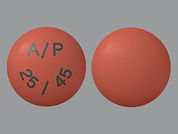Oseni
Alogliptin Benz/Pioglitazone
What is Oseni used for?
This combination medication is used with a proper diet and exercise program to control high blood sugar in people with type 2 diabetes. Controlling high blood sugar helps prevent kidney damage, blindness, nerve problems, loss of limbs, and sexual function problems. Proper control of diabetes may also lessen your risk of a heart attack or stroke. This product contains 2 medications: alogliptin and pioglitazone. Alogliptin works by increasing levels of natural substances called incretins. Incretins help to control blood sugar by increasing insulin release, especially after a meal. They also decrease the amount of sugar your liver makes. Pioglitazone works by helping to restore your body's proper response to insulin.
CHEMICAL NAME
DRUG TYPE
DiabetesOseni Prices
Searching for the lowest prices
Oseni Frequently Asked Questions
Before taking this medication, tell your doctor or pharmacist if you are allergic to alogliptin or pioglitazone; or if you have any other allergies. This product may contain inactive ingredients, which can cause allergic reactions or other problems. Talk to your pharmacist for more details.
Before using this medication, tell your doctor or pharmacist your medical history, especially of: bladder cancer, heart problems (such as heart failure, chest pain), kidney disease, liver problems, fluid in your lungs, a certain eye problem (macular edema), disease of the pancreas (pancreatitis), stones in your gallbladder (gallstones), swelling (edema).
You may experience blurred vision, dizziness, or drowsiness due to extremely low or high blood sugar. Do not drive, use machinery, or do anything that needs alertness or clear vision until you are sure you can perform such activities safely.
Limit alcohol while taking this medication because it can increase the risk of developing low blood sugar.
It may be harder to control your blood sugar when your body is stressed (such as due to fever, infection, injury, or surgery). Consult your doctor because this may require a change in your treatment plan, medications, or blood sugar testing.
Before having surgery, tell your doctor or dentist about all the products you use (including prescription drugs, nonprescription drugs, and herbal products).
This medication may increase the risk of bone fracture (usually in the forearm, wrist, hand, or foot), especially in women. See also Notes section.
This medication can cause changes in a woman's menstrual cycle (promote ovulation) and increase the chance of pregnancy. Consult your doctor or pharmacist about using reliable birth control while taking this medication.
During pregnancy this medication should be used only when clearly needed. Pregnancy may cause or worsen diabetes. Discuss a plan with your doctor for managing your blood sugar while pregnant. Your doctor may change your diabetes treatment during your pregnancy (such as diet, exercise, and medications including insulin).
It is unknown if this drug passes into breast milk. Consult your doctor before breastfeeding.
See also Warning section.
Sore throat, muscle pain, or weight gain may occur. If any of these effects last or get worse, tell your doctor or pharmacist promptly.
Remember that this medication has been prescribed because your doctor has judged that the benefit to you is greater than the risk of side effects. Many people using this medication do not have serious side effects.
Tell your doctor right away if you have any serious side effects, including: new/worsening vision problems (such as blurred vision), bone fracture, reddish-colored urine, frequent/painful urination, joint pain, unusual skin blisters.
Get medical help right away if you have any very serious side effects, including: signs of pancreatitis (such as nausea/vomiting that doesn't stop, loss of appetite, severe stomach/abdominal/back pain), dark urine, yellowing eyes/skin.
Although this medication by itself usually does not cause low blood sugar (hypoglycemia), low blood sugar may occur if this drug is prescribed with other diabetes medications. Talk with your doctor or pharmacist about all your diabetes medication(s).
Symptoms of low blood sugar include sudden sweating, shaking, fast heartbeat, hunger, blurred vision, dizziness, or tingling hands/feet. It is a good habit to carry glucose tablets or gel to treat low blood sugar. If you don't have these reliable forms of glucose, rapidly raise your blood sugar by eating a quick source of sugar such as table sugar, honey, or candy, or drink fruit juice or non-diet soda. Tell your doctor about the reaction right away. Low blood sugar is more likely if you drink large amounts of alcohol, do unusually heavy exercise, or do not consume enough calories from food. To help prevent low blood sugar, eat meals on a regular schedule, and do not skip meals. Talk with your doctor or pharmacist about what to do if you miss a meal.
Symptoms of high blood sugar (hyperglycemia) include increased thirst/urination. If these symptoms occur, tell your doctor right away. Your doctor may need to adjust your diabetes medication, exercise program, or diet.
A very serious allergic reaction to this drug is rare. However, get medical help right away if you notice any symptoms of a serious allergic reaction, including: rash, itching/swelling (especially of the face/tongue/throat), severe dizziness, trouble breathing.
This is not a complete list of possible side effects. If you notice other effects not listed above, contact your doctor or pharmacist.
In the US -
Call your doctor for medical advice about side effects. You may report side effects to FDA at 1-800-FDA-1088 or at www.fda.gov/safety/medwatch-fda-safety-information-and-adverse-event-reporting-program.
In Canada - Call your doctor for medical advice about side effects. You may report side effects to Health Canada at 1-866-234-2345.
